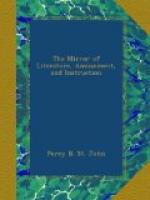united—after all this waste of sympathy,
he learns at last that he has been under a delusion
the whole time—that no Virginia was there
interred, and that it is a matter of doubt whether
there ever existed such a person as Paul! What
a pleasing illusion is then dispelled! How many
romantic dreams, inspired by the perusal of St. Pierre’s
tale, are doomed to vanish when the truth is ascertained!
The fact is, that these tombs have been built to gratify
the eager desire which the English have always evinced
to behold such interesting mementos. Formerly
only one was erected; but the proprietor of the place,
finding that all the English visiters, on being conducted
to this, as the tomb of Virginia, always asked to
see that of Paul also, determined on building a similar
one, to which he gave that appellation. Many
have been the visiters who have been gratified, consequently,
by the conviction that they had looked on the actual
burial-place of that unfortunate pair. These
“tombs” are scribbled over with the names
of the various persona who have visited them, together
with verses and pathetic ejaculations, and sentimental
remarks. St. Pierre’s story of the lovers
is very prettily written, and his description of the
scenic beauties of the island are correct, although
not even his pen can do full justice to them; but
there is little truth in the tale. It is said,
that there was indeed a young lady sent from the Mauritius
to France, for education, during the time that Monsieur
de la Bourdonnais was governor of the colony—that
her name was Virginia, and that she was shipwrecked
in the St. Geran. I heard something of a young
man being attached to her, and dying of grief for
her loss; but that part of the story is very doubtful.
The “Bay of the Tomb,” the “Point
of Endeavour,” the “Isle of Amber,”
and the “Cape of Misfortune,” still bear
the same names, and are pointed out as the memorable
spots mentioned by St. Pierre.—
Recollections
of the Mauritius.
* * * *
*
THE COSMOPOLITE.
* * * *
*
COINCIDENT POPULAR SUPERSTITIONS.
(For the Mirror.)
In No. 475 of the Mirror, p. 98, will be found
an article by a correspondent (H.) on “English
Superstition,” introducing a very interesting
Cheshire legend, as a counterpart to a Scottish one,
related by the celebrated author of “Demonology
and Witchcraft.” H. remarks of his tale
that “it gives rise to many interesting conjectures
respecting the probable causes of such a superstition
being believed in countries with apparently so little
connexion or intercourse as Cheshire and Scotland.”
Perhaps it may be as well to refer to what Sir W.
Scott has said upon this very subject, in note xi.
to canto 4 of his “Lady of the Lake,” ere
we proceed to utter a few specimens of coincident
superstitions:—




